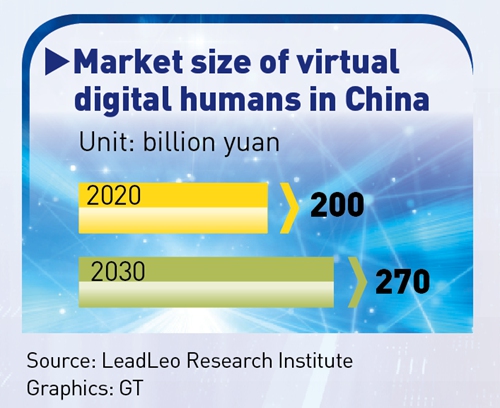Virtual broadcasters at Beijing Winter Olympics offer a glimpse into China's rapid developing industry
A glimpse into the fast growth of a nascent yet futuristic industry

Photo: VCG
"Hello, audience. The outdoor sports watching index reached level four at the National Ski Jumping Centre on Monday. Because of weather influence, speculators watching outdoor matches in winter should enhance self-protection abilities," said Feng Shu, a popular weather broadcaster at China Central Television's weather forecast program.
But a close look at the broadcaster reveals that he is not the "real" Feng Shu, but a digital simulated portrait of him. His real identity is an artificial intelligence (AI) virtual weather broadcaster jointly created by the Huafeng Meteorological Media Group and China-based AI chatbot developer Xiaoice. Looking almost exactly like the real Feng, the virtual broadcaster is in charge of broadcasting weather indices during the Beijing 2022 Winter Olympic Games.
According to information revealed by Xiaoice, the team behind the virtual weather broadcast has applied technologies such as Xiaoice Neural Rendering, which made it possible to simulate Feng Shu's expressions, face characteristics and body movements in the virtual broadcaster.
To some extent, it also offers a glimpse to the fact that China's virtual human industry is experiencing high speed development, with virtual humans entering different industries and assuming different job positions in recent years, stirring anticipation for this nascent yet futuristic arena.

Growing industry
It is no exaggeration to say that the Beijing 2022 Winter Olympic Games has become a stage for displaying China's virtual human technologies. Apart from the aforementioned virtual weather broadcaster, audiences can also find the virtual images of several Chinese Winter Olympic athletes, including the popular star skier Gu Ailing, on the livestreaming shows on Migu, a leading multimedia and on-demand content service provider in China during the Games. When athletes are competing on the venues, the virtual ones are in charge of jobs such as the Games commentary and broadcasting.
Besides, virtual sign language hosts are also applied during the Beijing 2022 Winter Olympic Games, who take the job of translation using sign language for the athletes.
These aforementioned virtual people are an epitome of the rise of virtual human market in China, as technologies behind those projects are becoming increasingly mature and as investors rush to pour capital into the sectors.
Demand is rising as well, as more and more companies are paying money to "customize" their virtual human employees and assigning various tasks from hosting problems, calculating data to communicating with customers on the internet.
According to data sent by Baidu to the Global Times, China's virtual human industry has passed the first generation of "paper images" (like images created in games or animation") as well as the second generation of virtual anchors, and entered the third generation of AI-driven, high precision models, said Li Shiyan, head of Baidu Intelligent Cloud AI Human-Computer Interaction Laboratory.
"In the industry network of virtual humans, companies that provide basic virtual human making services such as model construction and motion capture are mostly overseas firms, but in terms of tools and applications, Chinese companies are starting to make a name," Li said.
On the demand side, more and more companies in China are moving to customize virtual humans and assign them different jobs. Chinese real estate giant Vanke, for example, hired the company's first digital human employee named Cui Xiaopan. The person, designed in the image of a beautiful young lady, is in charge of sending emails to employees reminding them of outstanding work items and overdue incidents after checking those flaws with "her" innate system algorithm, according to information sent by Vanke to the Global Times on Monday.
Vanke said that the original intention of hiring Cui was to boost coordinated work between the digital and human world, with very encouraging results. According to the company, the rate of response to documents handled by Cui has been seven times that of traditional IT system warnings, which is proof of employees' welcome and willingness to coordinate with their digital colleague.
The surging demands for digital employees like Cui, as well as the maturing technologies, have pushed China's digital human industry to burgeon at a fast rate in recent years. Data revealed by China's corporate information website tianyancha.com showed that there were 16 fundraising investments in digital human areas in 2021 in China, up from 10 in 2020 and six in 2019. From 2016 to 2020, the number of newly registered virtual human companies experienced a compound growth rate of nearly 60 percent.
By 2030, the total market size of China's virtual humans is forecast to reach 270 billion yuan ($42.4 billion), according to an industry report published by QbitAI on December 23, 2021. The market size of character-based virtual humans will be about 175 billion yuan and that of service-oriented virtual humans to exceed 95 billion by 2030. The current market is still in the early stage of cultivation, read the report.

Virtual figures on the platform of Baidu Intelligent Yunxiling Photo: Courtesy of Baidu
Challenges ahead
However, the industry's development still faces a lot of challenges, particularly when it comes to the vision of wide-scale production or industrial landing, experts said.
One problem is that the industry of virtual humans is highly fragmented, which means that most companies can only engage in one or several links of the whole industry of virtual human manufacturing or operation. Besides, the cost of making a highly mobile digital human remains high, Li said.
Zheng Lei, a chief economist with Glory Sun Financial Group, told the Global Times that most digital humans only undertake auxiliary work such as customer service and performance currently, backed by technologies like image or voice recognition, and intelligent interaction.
"There's not much technological difficulty in making this sort of virtual human in large scale, but when it comes to virtual human in metaverse, which should be the virtual equivalent of real world people, there's still a lot of gap whether in terms of technology, scenario, laws or social acceptance," Zheng said.
Some experts also said that the penetration rate of digital humans in the services industries has been quite high already, with a lot of them being made to treat customer inquiries on e-commerce websites, but their spread also poses a danger to China's job market, thus causing further controversy.




